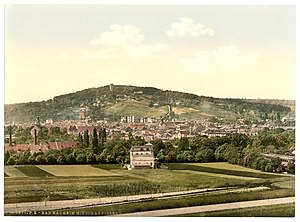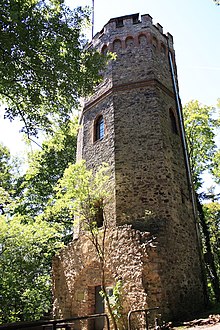Johannisberg (Bad Nauheim)
| Johannisberg | ||
|---|---|---|
|
Johannisberg around 1900 |
||
| height | 268 m above sea level NHN | |
| location | Wetteraukreis , Hessen , Germany | |
| Mountains | Taunus | |
| Coordinates | 50 ° 21 '54 " N , 8 ° 43' 38" E | |
|
|
||
| particularities | Ground monument | |
The Johannisberg in Bad Nauheim is located in the west of the city and is a projection of the Taunus in the plane of the Wetterau . The mountain is 268 m above sea level. NHN high.
Historical meaning
The mountain has a number of historical and archaeological cultural monuments . It is a ground monument according to the Hessian Monument Protection Act .
There are finds from the Michelsberg culture and cord ceramics from the Neolithic period . The finds condense in the Urnfield Period, so that a hilltop settlement is assumed here for this period. The largest amount of finds comes from the Hallstatt and Latène times , so that a hilltop settlement is also assumed for this period, the inhabitants of which probably operated the salt production in Bad Nauheim. To this settlement belonged a section wall protecting the mountain backwards , which has been preserved at a height of about two meters. The two archaeological excavations carried out there are undocumented. The inner core is said to have consisted of a dry stone wall with wooden fixtures, which is dated Celtic . The wall was rebuilt in the High Middle Ages .
In Roman times there was a signal tower here since the 2nd century, which was part of the Upper German Limes system . Structurally it resembled a Limes watchtower . Presumably it was used to transmit optical signals from the Limes to Friedberg Fort , which had no direct line of sight to the nearest Limes watchtower on the Gaulskopf . There were other rear watchtowers of this type on Kapellenberg near Hofheim and near Wölfersheim-Wohnbach. The remains of the Roman signal tower were restored in 2010 and it was also made clear which parts are original and which additions.
This Roman tower must not be confused with the tower that is still standing today, the substructure of which dates from around 1300. The octagonal tower was part of the westwork of the church of a medieval monastery, which goes back to a mission church that is said to have been built here in 779. This Johanniskirche is considered the baptismal and mother church and original parish of the whole northern Wetterau. The right of patronage to the church was transferred from Ulrich II von Munzenberg to the Mainz cathedral chapter in 1254 .
This donation was contested soon afterwards because it had been closed without the knowledge of the Fulda abbey (as feudal lord of the Bad Nauheim property of the Munzenberg family). The subsequent legal dispute between the Imperial Abbey of Fulda and Archbishop Mainz lasted until 1319, with the Archbishop already taking possession of the entire monastery on the mountain above Bad Nauheim in the course of the legal dispute in 1310. During the Reformation , the church was abandoned and fell into disrepair, although documents from the Bad Nauheim town archive showed that the church was finally destroyed in 1596. The tower, still preserved in its foundation walls, was expanded as a viewing tower in 1866 and has housed the Wetterau public observatory since 1965 .
Todays use
The Johannisberg is an outstanding vantage point with a view over the old town of Bad Nauheim, the Wetterau up to the Vogelsberg .
On the mountain is the Café Restaurant Johannisberg , a traditional restaurant that was already visited by Empress Elisabeth of Austria during her spa stay.
Wine was grown on the Johannisberg until the end of the 19th century . This is said to have been the case since at least the 15th century. Viticulture was given up around 1900, as the town, as the owner of the slope, lost interest in labor-intensive viticulture. In 1997 the now overgrown slope was restored. The " Freundeskreis Weinanbau Johannisberg " has replanted the former Wingert with vines .
At the end of Bad Nauheimer Parkstrasse is the memorial for soldiers inaugurated in 1933 for the victims of soldiers from both world wars. The memorial designed by government building officer August Metzger consists of Weiberner tuff .
literature
- Georg Dehio , Handbook of German Art Monuments - Hesse II. Administrative Region Darmstadt. (Ed .: Folkhard Cremer and Tobias Michael Wolf), 3rd edition, Munich 2008, p. 43.
- Albrecht Jockenhövel : Bad Nauheim . In: Fritz-Rudolf Herrmann , Albrecht Jockenhövel: The prehistory of Hesse. Theiss, Stuttgart 1990, ISBN 3-8062-0458-6 , p. 314f.
- Hans-Günther Simon : Bad Nauheim . In: Dietwulf Baatz / Fritz-Rudolf Herrmann (ed.): The Romans in Hessen . Licensed edition of the 1989 edition, Nikol, Hamburg 2002, ISBN 3-933203-58-9 , p. 238.
Web links
- The Johannisberg ( Memento from May 19, 2011 in the Internet Archive ) on the homepage of the city of Bad Nauheim
- Friends of Viticulture Johannisberg
- Johannisberg in the Rhein-Main-Wiki
Individual evidence
- ↑ Thomas Becker: Roman signal tower on the Bad Nauheimer Johannisberg renovated . In: Preservation of monuments and cultural history 1/2010, p. 41f; Thomas Becker u. a .: Conservation of the signal tower foundation on the Johannisberg . In: Der Limes - newsletter of the German Limes Commission 2011/1, pp. 30–33.


